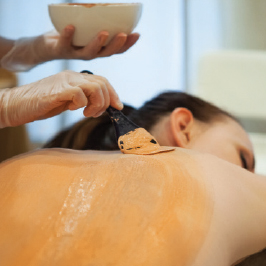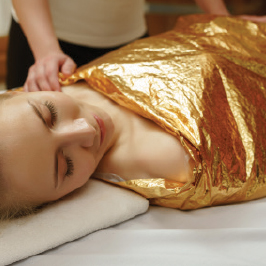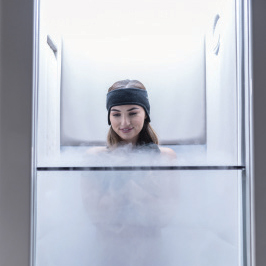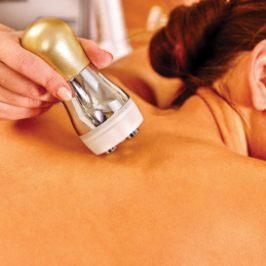Most facials end at the clavicle or bottom of the throat. The approach to “facials” used in the last four decades was bothersome. Traditionally, a facial seemed to be a cleanse, massage, mask, or machine mask (galvanic masks were very popular in the 1930s). A toner usually followed this and, finally, a nurturing cream was applied.
The variety of exotic creams applied in salons of that era – all the way to the 1960s – can be seen in many old films, like “Mrs. Skeffington” starring Bette Davis.
In fact, during those days, creams were not considered moisturizers. This came later in 1962, when a New York advertising firm coined the term moisturizer to sell beauty creams.
The many exotic creams that were used in salons by Pierre, André, or Ilona of Hungary were either lifting creams, whitening freckle creams, or wrinkle smoothing creams, all endowed with special ingredients known only to Pierre, André, or Ilona, usually passed down from a European grandmother.
 But this idea of a facial was inconclusive and insufficient. It is important to look at everything on the client – from head to toe – even if they book for just a face treatment.
But this idea of a facial was inconclusive and insufficient. It is important to look at everything on the client – from head to toe – even if they book for just a face treatment.
Looking at the body as a whole, professionals can find indications of the client’s real age via areas that are not subject to constant environmental attack or solar radiation. Often, other body areas are 10 or even 20 years younger in appearance. This can give an indication of how much work and time it will take to revise the defense systems of the face, backs of the hands, and neck that are constantly exposed.
Using this whole-body approach to skin care garnered laughs from seasoned European facialists back in the 1970s. But, today, this approach is accepted as logical.
Looking at other areas of a client’s skin, professionals can take notes and verbally mention things such as hyperpigmented hands, cellulite on thighs, and so forth. Besides getting a clear picture of the client’s physiology, doing so makes them aware that these areas can be treated. Many women do not think much can be done for aging hands, but drawing attention to these areas can begin to open a client’s mind for future appointments.
A professional, personal diagnostic approach to skin care is a more effective tool for adding body services to a menu than solo promotion and advertisement. When a therapist shows personal attention to areas of the body the client is concerned about – but seldom takes any steps to alleviate – a relationship begins in which the client is viewed as a whole and not just as a face.
Lymph System
The Dr. Vodder method of lymph drainage is a venerable approach to detoxification and pain management that has been offered in many hospitals and rehabilitation centers in Europe for many decades now.
A Scandinavian student of Dr. Emil Vodder proved that through applying an enzyme mask from the areola up to the forehead and focusing on the lymph axions, homeostasis takes place almost immediately in very sallow and toxic skin.
This, of course, can be achieved manually with an actual “Dr. Vodder Lymph Drainage,” but such a vast area is tedious and time consuming for the modern age professional. In this case, a 45-minute enzyme treatment can do the work. Using a stronger enzyme treatment on the body – especially on crepe and dimpled skin on the inner and outer thighs – after a thermogenic-based body sculpting wrap simulates the Dr. Vodder Method in those areas.
 Body Sculpting
Body Sculpting
Body sculpting works with thermogenesis or pseudo heat. Toxic adipose fat cells can harden and clump together under the epidermis while normal adipose cells stay smooth and organized. Together, they give a dimpled orange peel look to the area.
The plastic body wrapping has no porosity, so the hot cream underneath keeps bouncing the pseudo heat in the transepidermal cream back and forth between the plastic and the skin. Having nowhere else to go, the heat gradually hydrolyzes the hardened toxic fat cells until they change to a more liquid state with the same configuration as the normal, smooth adipose fat cells, resulting in a more uniform, tighter skin appearance.
Using cryotherapy for puffy, swollen, water-filled cellulite pushes liquid away from the site, reducing the puffy look in this type of cellulite. Often, a combination of both cryotherapy and thermotherapy can change all categories of cellulite.
The body is one continuous, complex cell structure supported by a copious fascia, the largest organ of the body. What is going on below is an indication of what is going on up top – starting with the feet and all the sensory mechanisms associated with the feet. This may have been the genesis of reflexology by the ancient practitioners, as they noted that feet were relieved of constrictor and heavy cuticles, which also showed up in faces deeply lined with stress wrinkles and grooves where muscles were immobilized by constant pain.
Three Cleavage Treatments
Some clients may struggle with three cleavage lines in the decollate. This is due to a prolapse of the tissue from the clavicle down to the under-breast area and atrophied pectoris major muscles. In addition, these same clients often experience a “V”-shaped area of hyperpigmentation and defined melasmas that create an aged look.
No matter how many surgeries, fillers, and Botox injections this type of client may have received, a rattled decollate and spotty, chicken-skinned backs of hands are a dead giveaway of aging skin. Skin that has been compromised by environmental attack and weakened muscles is tugged at constantly by gravity. Is it possible to reverse these conditions? Yes. It takes time and compliance on behalf of the client with their homecare regimen.
It is also simple to extend treatments as far down as about a centimeter above the areola after applying treatment products to the face. This includes pre-exfoliation or full-blown resurfacing protocol in the case of using either acidic or alkaline removal systems. Getting off dead cuticle buildup opens the door, but is not the final treatment. Controlled injury to the skin to promote more collagen in such a vast area can backfire and lead to even more irritation, hyperpigmentation, and even chronic inflammation.
 This is where body enzymes really shine. Hyperpigmented skin cells can gently, but firmly, be removed. With the extra circulation following this method, new oxygen from the lungs is rushed to the mitochondria of the skin cells.
This is where body enzymes really shine. Hyperpigmented skin cells can gently, but firmly, be removed. With the extra circulation following this method, new oxygen from the lungs is rushed to the mitochondria of the skin cells.
A daily infusion of ingredients skin cells recognize – such as proteins, essential amino acids, and, of course, a full complement of antioxidants – can prevent further damage. In turn, skin will become more creamy, bouncy, and turgid.
For breast and buttock elevation, the pectoris muscles can be strengthened again with body enzymes that utilize thermogenic technology. The principle is rather like isometric exercises popular back in the era of fitness icon Jack LeLaine. This method forces the muscle to contract in on itself from entrance and exit points. Microcurrent can be used here as well to kickstart the muscle mass. After 30 minutes, more and more motor neurons are fired across the muscle in a synchronous motion, thus building up the muscle fibers.
The same procedure can be applied to the gluteus maximus and both areas will get a measurable lift that can be maintained over extended periods of time. Although results are notable after the first treatment, it usually takes four treatments for about once a week each month to get a discernable effect.
Bacne
Many men – particularly weight lifters on anabolic steroids – and teenagers suffer from acne on the back and chest areas. This can be full blown acne vulgaris or simple folliculitis that suddenly appears on the shoulders or upper arms. For women, this usually occurs after menopause.
With lowered estrogen, vellus, invisible hairs become more predominant and sebaceous glands become impacted and micro-encapsulated forming bumps.
An alkaline removal system desquamating all old and congested proteins in the skin, including superfluous hair, followed by getting the pH of the skin back to normal and a body enzyme, can restore all the functions of the skin.
Alkaline Removal System
Alkaline wash products are like playing the piano on the pH scale in that carefully maneuvering up and down the scales can produce harmonious results. Going down the scale to less than four acidifies the area being treated. Dead cells become brittle and break away from the underlying tissue, which is preferred in cases where dead cell removal is required.
 But, going up the scale to a higher pH does the opposite. It softens everything within moments and desquamates dead cells, superfluous hair, the tissue that forms over pustules, and milia on acne clients. Often, pre-deposited fats loaded with P. acnes bacteria flood out of the skin
But, going up the scale to a higher pH does the opposite. It softens everything within moments and desquamates dead cells, superfluous hair, the tissue that forms over pustules, and milia on acne clients. Often, pre-deposited fats loaded with P. acnes bacteria flood out of the skin
An alkaline wash must be timed exactly and controlled, which requires special training. Alkaline and acids can both burn the skin.
Alkaline is ideal for scar revision treatments and hyperpigmentation, as well as acne vulgaris.
Male bacne can be treated similarly but extra tools and treatments may be needed, including cuneiform scar revision. Compliance from the client is essential. Some men have hair on their chest. Alkaline procedures on the chest will temporarily remove that hair. The hair will grow back, although softer and a little weaker, but this is a small sacrifice to make for healthy chest skin that is not riddled with red and purple pustules, papules, or sebaceous cysts.
In summary, treating the body as an extension of the face can not only provide the client with even more confidence in their lifestyle, but can also increase profits by 50 percent
or more.
Of course, these advanced methods of resurfacing and rebuilding skin take in-depth training. Highly active products and precise protocols could do harm if performed by untrained hands.
 DMK founder, Danné Montague-King, is a pioneer in his industry. He has seen the depths of depression associated with poorly functioning skin. In fact, his everlasting passion was born from his dissatisfaction with his own acne as a teenager. From not understanding the condition completely, to failed attempts from top United States dermatologists to cure his acne, Montague-King had to take things into his own hands and, desperate for a cure, became his own guinea pig. A string of breakthroughs, trials, tribulations, and many travels would follow, until he found his first true breakthrough in the 1960s, involving vitamin C therapy. That sparked what would be decades of developing successful treatments and products that would combine to form the iconic brand that is DMK – sold throughout 30 countries.
DMK founder, Danné Montague-King, is a pioneer in his industry. He has seen the depths of depression associated with poorly functioning skin. In fact, his everlasting passion was born from his dissatisfaction with his own acne as a teenager. From not understanding the condition completely, to failed attempts from top United States dermatologists to cure his acne, Montague-King had to take things into his own hands and, desperate for a cure, became his own guinea pig. A string of breakthroughs, trials, tribulations, and many travels would follow, until he found his first true breakthrough in the 1960s, involving vitamin C therapy. That sparked what would be decades of developing successful treatments and products that would combine to form the iconic brand that is DMK – sold throughout 30 countries.